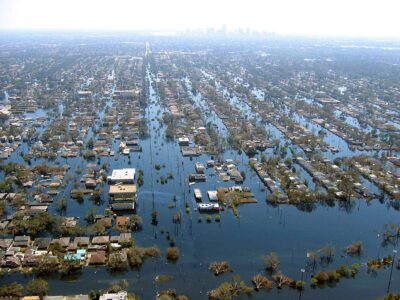
Above: New Orleans in the aftermath of Hurricane Katrina, showing Interstate 10 at West End Boulevard, looking towards Lake Pontchartrain. more about this photo
Photo credit: U.S. Coast Guard, Petty Officer 2nd Class Kyle Niemi
How do we fully account for the people killed by Hurricane Katrina? Should we count the kidney dialysis patient who died when treatment was interrupted? What about a despondent evacuee who committed suicide months after leaving New Orleans? Or the suspected looter shot in the street?
More importantly, what happens to our understanding of the storm’s impact on society if these and other uncounted are added to the list of those who drowned?
These are the questions John Mutter, deputy director of The Earth Institute at Columbia University, hopes to answer through a new project that seeks to compile an online list of all Gulf Coast residents who died as a result of direct and indirect effects of the storm, and as a result of the victims’ social standing or decisions made by policy makers.
“Socially marginalized people are always at greatest physical risk because they occupy the riskiest environments,” Mutter wrote in a recent article about Katrina deaths. “They live on steep, landslide-prone slopes of the barrios that surround major cities in poor countries. They live in swamps and flood-prone riverbanks of urban peripheries. They live in poorly built houses that collapse easily when shaken by earthquakes or a wrecked by flood waters. They lived in the 9th Ward of New Orleans.”
Mutter and research assistant Amatullah R’id compiled their list by reviewing obituaries and coroners’ lists. They followed up with calls to family members, churches, and social service organizations to build a more comprehensive picture of each victim.
Mutter and R’id are reaching out to the affected communities, asking for friends and relatives to contribute information and revise existing information about those who died in New Orleans or elsewhere.
“More than one year later, the human and economic consequences of Katrina — including the causes and circumstances of deaths attributable to this catastrophic event — have still not been fully clarified,” said Irwin Redlener, director of the National Center for Disaster Preparedness at Columbia’s Mailman School of Public Health. “This work will reveal critical information about the true human toll of a natural megadisaster, providing closure to families and critical insight to disaster response planners.”
To date, Mutter and R’id have collected more than 1,250 names, nearly 25 percent of which have yet to be accounted for officially. A report by the Louisiana Family Assistance Center, a group that was formed to help locate the missing, puts the total dead at 1,460, with 135 still missing as of August.
According to R’id, however, this total does not include the estimated 246 people who died in Mississippi and Texas — more than 100 of which she and Mutter have been able to confirm through official and unofficial sources.
The difficulty they have encountered in determining whether an individual died directly or indirectly of causes related to the storm points to an inherent weakness in our understanding of how natural disasters affect society. Mutter believes that, until we answer these questions and account for every victim of Katrina — whether they died at home in New Orleans or with relatives in California — we will never be fully prepared for the next storm.
“We can’t understand any disaster from just the natural perspective,” said Mutter. “Blaming nature for what happens abdicates us from our moral responsibility to help people.”



